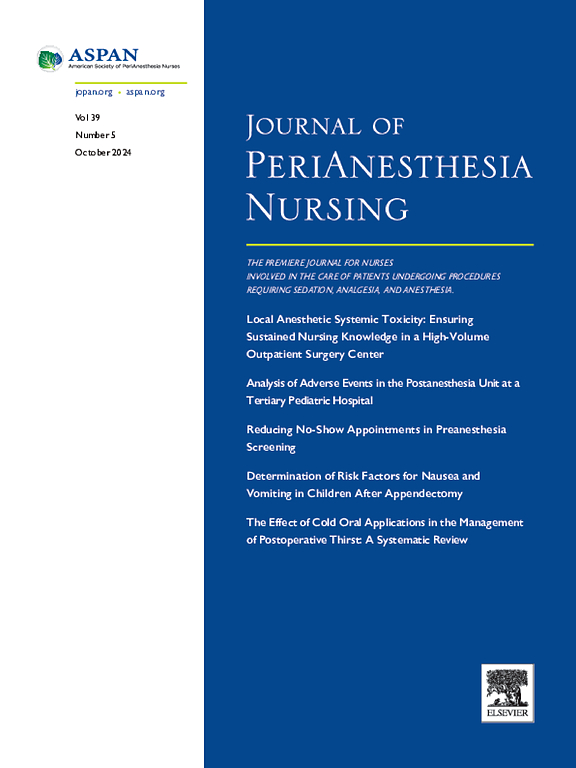Effects of Remifentanil Pretreatment on Sufentanil-induced Cough Suppression During the Induction of General Anesthesia
IF 1.6
4区 医学
Q2 NURSING
引用次数: 0
Abstract
Purpose
The aim of this study was to evaluate the effect of remifentanil pretreatment on sufentanil-induced cough during general anesthesia induction.
Design
This experimental research was conducted as a single-center, randomized, parallel-group trial.
Methods
A total of 120 patients scheduled for elective surgery were equally randomized into two groups (remifentanil and control). The incidence and severity of coughing in both groups were recorded after sufentanil administration during general anesthesia induction. The mean arterial pressure, heart rate, and pulse oxygen saturation were recorded at T1 (before the injection of remifentanil or normal saline), T2 (1 minute after remifentanil administration), T3 (before intubation), and T4 (1 minute after intubation). Additionally, the incidences of adverse events, including dizziness, nausea, apnea, truncal rigidity, bradycardia, or other adverse effects were also recorded.
Findings
The incidence of sufentanil-induced cough in the remifentanil group was significantly decreased when compared with the control group (5.0% vs 35.0%, respectively; P < .001). No statistical differences were found in mean arterial pressure, heart rate, pulse oxygen saturation, and the incidences of other side effects between the two groups at T1, T2, T3, and T4 (P > .05).
Conclusions
Pretreatment with remifentanil at a dose of 0.5 mcg/kg can effectively and safely suppress the incidence and severity of sufentanil-induced coughing, providing a reference for medication during general anesthesia induction.
瑞芬太尼预处理对全身麻醉诱导过程中苏芬太尼诱发的咳嗽抑制的影响
目的:本研究旨在评估瑞芬太尼预处理对全身麻醉诱导期间舒芬太尼引起的咳嗽的影响:设计:本实验研究为单中心、随机、平行组试验:方法:将 120 名择期手术患者平均随机分为两组(瑞芬太尼组和对照组)。在全身麻醉诱导过程中给予舒芬太尼后,记录两组患者咳嗽的发生率和严重程度。分别在 T1(注射瑞芬太尼或生理盐水前)、T2(注射瑞芬太尼后 1 分钟)、T3(插管前)和 T4(插管后 1 分钟)记录平均动脉压、心率和脉搏氧饱和度。此外,还记录了不良事件的发生率,包括头晕、恶心、呼吸暂停、躯干僵硬、心动过缓或其他不良反应:结果:与对照组相比,瑞芬太尼组舒芬太尼引起的咳嗽发生率明显降低(分别为 5.0% vs 35.0%;P 1、T2、T3 和 T4(P > .05)):结论:0.5 mcg/kg 剂量的瑞芬太尼预处理可有效、安全地抑制舒芬太尼诱发咳嗽的发生率和严重程度,为全身麻醉诱导期间的用药提供了参考。
本文章由计算机程序翻译,如有差异,请以英文原文为准。
求助全文
约1分钟内获得全文
求助全文
来源期刊

Journal of Perianesthesia Nursing
NURSING-
CiteScore
2.20
自引率
17.60%
发文量
279
审稿时长
90 days
期刊介绍:
The Journal of PeriAnesthesia Nursing provides original, peer-reviewed research for a primary audience that includes nurses in perianesthesia settings, including ambulatory surgery, preadmission testing, postanesthesia care (Phases I and II), extended observation, and pain management. The Journal provides a forum for sharing professional knowledge and experience relating to management, ethics, legislation, research, and other aspects of perianesthesia nursing.
 求助内容:
求助内容: 应助结果提醒方式:
应助结果提醒方式:


